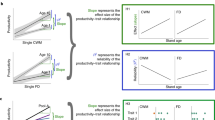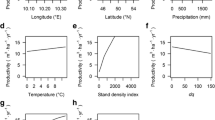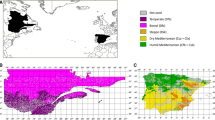Abstract
Forest diversity-productivity relationships have been intensively investigated in recent decades. However, few studies have considered the interplay between species and structural diversity in driving productivity. We analyzed these factors using data from 52 permanent plots in southwestern Germany with more than 53,000 repeated tree measurements. We used basal area increment as a proxy for productivity and hypothesized that: (1) structural diversity would increase tree and stand productivity, (2) diversity-productivity relationships would be weaker for species diversity than for structural diversity, and (3) species diversity would also indirectly impact stand productivity via changes in size structure. We measured diversity using distance-independent indices. We fitted separate linear mixed-effects models for fir, spruce and beech at the tree level, whereas at the stand level we pooled all available data. We tested our third hypothesis using structural equation modeling. Structural and species diversity acted as direct and independent drivers of stand productivity, with structural diversity being a slightly better predictor. Structural diversity, but not species diversity, had a significant, albeit asymmetric, effect on tree productivity. The functioning of structurally diverse, mixed forests is influenced by both structural and species diversity. These sources of trait diversity contribute to increased vertical stratification and crown plasticity, which in turn diminish competitive interferences and lead to more densely packed canopies per unit area. Our research highlights the positive effects of species diversity and structural diversity on forest productivity and ecosystem dynamics.



Similar content being viewed by others
References
Bauhus J, Khanna P, Menden N (2000) Aboveground and belowground interactions in mixed plantations of Eucalyptus globulus and Acacia mearnsii. Can J For Res 30:1886–1894. doi:10.1139/x00-141
Bauhus J, Van Winden AP, Nicotra AB (2004) Aboveground interactions and productivity in mixed-species plantations of Acacia mearnsii and Eucalyptus globulus. Can J For Res 34:686–694. doi:10.1139/x03-243
Berrill J-P, O’Hara KL (2013) Estimating site productivity in irregular stand structures by indexing the basal area or volume increment of the dominant species. Can J For Res 44:92–100. doi:10.1139/cjfr-2013-0230
Box GE, Cox DR (1964) An analysis of transformations. J R Stat Soc Ser B Stat Methodol 26:211–252
Buongiorno J, Dahir S, Lu H-C, Lin C-R (1994) Tree size diversity and economic returns in uneven-aged forest stands. For Sci 40:83–103
Canham CD (1989) Different responses to gaps among shade-tolerant tree species. Ecology 70:548–550. doi:10.2307/1940200
Clark JS (2010) Individuals and the variation needed for high species diversity in forest trees. Science 327:1129–1132
Condés S, Sterba H (2005) Derivation of compatible crown width equations for some important tree species of Spain. For Ecol Manage 217:203–218. doi:10.1016/j.foreco.2005.06.002
Cotta H (1828) Anweisung zum Waldbau, 4th edn. Arnoldische Buchhandlung, Dresden
Dormann CF, Elith J, Bacher S, Buchmann C, Carl G, Carré G, Marquéz JRG, Gruber B, Lafourcade B, Leitão PJ, Münkemüller T, McClean C, Osborne PE, Reineking B, Schröder B, Skidmore AK, Zurell D, Lautenbach S (2013) Collinearity: a review of methods to deal with it and a simulation study evaluating their performance. Ecography 36:27–46. doi:10.1111/j.1600-0587.2012.07348.x
Fahey RT, Fotis AT, Woods KD (2015) Quantifying canopy complexity and effects on productivity and resilience in late-successional hemlock–hardwood forests. Ecol Appl 25:834–847. doi:10.1890/14-1012.1
Fichtner A, Forrester DI, Härdtle W, Sturm K, von Oheimb G (2015) Facilitative-competitive interactions in an old-growth forest: the importance of large-diameter trees as benefactors and stimulators for forest community assembly. PLoS One 10:e0120335. doi:10.1371/journal.pone.0120335
Forrester DI (2014) The spatial and temporal dynamics of species interactions in mixed-species forests: from pattern to process. For Ecol Manage 312:282–292
Franklin JF, Spies TA, Pelt RV, Carey AB, Thornburgh DA, Berg DR, Lindenmayer DB, Harmon ME, Keeton WS, Shaw DC (2002) Disturbances and structural development of natural forest ecosystems with silvicultural implications, using Douglas-fir forests as an example. For Ecol Manage 155:399–423. doi:10.1016/S0378-1127(01)00575-8
Gamfeldt L, Snäll T, Bagchi R, Jonsson M, Gustafsson L, Kjellander P, Ruiz-Jaen MC, Fröberg M, Stendahl J, Philipson CD, Mikusiński G, Andersson E, Westerlund B, Andrén H, Moberg F, Moen J, Bengtsson J (2013) Higher levels of multiple ecosystem services are found in forests with more tree species. Nat Commun 4:1340. doi:10.1038/ncomms2328
Gough CM, Vogel CS, Hardiman B, Curtis PS (2010) Wood net primary production resilience in an unmanaged forest transitioning from early to middle succession. For Ecol Manage 260:36–41. doi:10.1016/j.foreco.2010.03.027
Grace JB (2006) Structural equation modeling and natural systems. Cambridge University Press, Cambridge
Grace JB, Bollen KA (2005) Interpreting the results from multiple regression and structural equation models. Bull Ecol Soc Am 86:283–295. doi:10.1890/0012-9623(2005)86[283:ITRFMR]2.0.CO;2
Grossiord C, Granier A, Ratcliffe S, Bouriaud O, Bruelheide H, Chećko E, Forrester DI, Dawud SM, Finér L, Pollastrini M (2014) Tree diversity does not always improve resistance of forest ecosystems to drought. Proc Natl Acad Sci USA 111:14812–14815. doi:10.1073/pnas.1411970111
Hanewinkel M, Kuhn T, Bugmann H, Lanz A, Brang P (2014) Vulnerability of uneven-aged forests to storm damage. Forestry 87:525–534. doi:10.1093/forestry/cpu008
Hardiman BS, Bohrer G, Gough CM, Vogel CS, Curtis PS (2011) The role of canopy structural complexity in wood net primary production of a maturing northern deciduous forest. Ecology 92:1818–1827. doi:10.1890/10-2192.1
Hardiman BS, Gough CM, Halperin A, Hofmeister KL, Nave LE, Bohrer G, Curtis PS (2013) Maintaining high rates of carbon storage in old forests: a mechanism linking canopy structure to forest function. For Ecol Manage 298:111–119. doi:10.1016/j.foreco.2013.02.031
Hooper DU, Chapin F III, Ewel J, Hector A, Inchausti P, Lavorel S, Lawton J, Lodge D, Loreau M, Naeem S (2005) Effects of biodiversity on ecosystem functioning: a consensus of current knowledge. Ecol Monogr 75:3–35. doi:10.1890/04-0922
Ishii HT, S-i Tanabe, Hiura T (2004) Exploring the relationships among canopy structure, stand productivity, and biodiversity of temperate forest ecosystems. For Sci 50:342–355
Jactel H, Brockerhoff EG (2007) Tree diversity reduces herbivory by forest insects. Ecol Lett 10:835–848. doi:10.1111/j.1461-0248.2007.01073.x
Jucker T, Bouriaud O, Avacaritei D, Dănilă I, Duduman G, Valladares F, Coomes DA (2014) Competition for light and water play contrasting roles in driving diversity–productivity relationships in Iberian forests. J Ecol 102:1202–1213. doi:10.1111/1365-2745.12276
Jucker T, Bouriaud O, Coomes DA (2015) Crown plasticity enables trees to optimize canopy packing in mixed-species forests. Funct Ecol 29:1078–1086. doi:10.1111/1365-2435.12428
Kelty MJ (1992) Comparative productivity of monocultures and mixed-species stands. In: Kelty MJ, Larson BC, Oliver CD (eds) The ecology and silviculture of mixed-species forests. Kluwer, Dordrecht, pp 125–141
Kelty MJ (2006) The role of species mixtures in plantation forestry. For Ecol Manage 233:195–204. doi:10.1016/j.foreco.2006.05.011
Kneeshaw DD, Kobe RK, Coates KD, Messier C (2006) Sapling size influences shade tolerance ranking among southern boreal tree species. J Ecol 94:471–480. doi:10.1111/j.1365-2745.2005.01070.x
Körner C (2005) An introduction to the functional diversity of temperate forest trees. In: Scherer-Lorenzen M, Körner C, Schulze E-D (eds) Forest diversity and function, vol 176. Springer, Heidelberg, pp 13–37
Kuehne C, Weiskittel AR, Fraver S, Puettmann KJ (2015) Effects of thinning-induced changes in structural heterogeneity on growth, ingrowth, and mortality in secondary coastal Douglas-fir forests. Can J For Res 45:1448–1461. doi:10.1139/cjfr-2015-0113
Lei X, Wang W, Peng C (2009) Relationships between stand growth and structural diversity in spruce-dominated forests in New Brunswick, Canada. Can J For Res 39:1835–1847. doi:10.1139/X09-089
Lexerød NL, Eid T (2006) An evaluation of different diameter diversity indices based on criteria related to forest management planning. For Ecol Manage 222:17–28. doi:10.1016/j.foreco.2005.10.046
Liang J, Buongiorno J, Monserud RA (2005) Growth and yield of all-aged Douglas-fir—western hemlock forest stands: a matrix model with stand diversity effects. Can J For Res 35:2368–2381. doi:10.1139/x05-137
Liang J, Buongiorno J, Monserud RA, Kruger EL, Zhou M (2007) Effects of diversity of tree species and size on forest basal area growth, recruitment, and mortality. For Ecol Manage 243:116–127. doi:10.1016/j.foreco.2007.02.028
Long JN, Shaw JD (2010) The influence of compositional and structural diversity on forest productivity. Forestry 83:121–128. doi:10.1093/forestry/cpp033
Loreau M, Hector A (2001) Partitioning selection and complementarity in biodiversity experiments. Nature 412:72–76. doi:10.1038/35083573
Magurran AE (2004) Measuring biological diversity. Blackwell, Malden
McElhinny C, Gibbons P, Brack C, Bauhus J (2005) Forest and woodland stand structural complexity: its definition and measurement. For Ecol Manage 218:1–24. doi:10.1016/j.foreco.2005.08.034
McGill BJ, Enquist BJ, Weiher E, Westoby M (2006) Rebuilding community ecology from functional traits. Trends Ecol Evol 21:178–185. doi:10.1016/j.tree.2006.02.002
Monserud RA, Sterba H (1996) A basal area increment model for individual trees growing in even-and uneven-aged forest stands in Austria. For Ecol Manage 80:57–80. doi:10.1016/0378-1127(95)03638-5
Morin X, Fahse L, Scherer-Lorenzen M, Bugmann H (2011) Tree species richness promotes productivity in temperate forests through strong complementarity between species. Ecol Lett 14:1211–1219. doi:10.1111/j.1461-0248.2011.01691.x
Naeem S (2002) Ecosystem consequences of biodiversity loss: the evolution of a paradigm. Ecology 83:1537–1552. doi:10.1890/0012-9658(2002)083[1537:ECOBLT]2.0.CO;2
Nakagawa S, Schielzeth H (2013) A general and simple method for obtaining R2 from generalized linear mixed-effects models. Methods Ecol Evol 4:133–142. doi:10.1111/j.2041-210x.2012.00261.x
Oberski D (2014) Lavaan. survey: an R package for complex survey analysis of structural equation models. J Stat Softw 57:1–27
Osawa A (1995) Inverse relationship of crown fractal dimension to self-thinning exponent of tree populations: a hypothesis. Can J For Res 25:1608–1617. doi:10.1139/x95-175
Paquette A, Messier C (2011) The effect of biodiversity on tree productivity: from temperate to boreal forests. Global Ecol Biogeogr 20:170–180. doi:10.1111/j.1466-8238.2010.00592.x
Parker GG (1997) Canopy structure and light environment of an old-growth Douglas-fir/western hemlock forest. Northwest Sci 71:261–270
Parker GG, Russ ME (2004) The canopy surface and stand development: assessing forest canopy structure and complexity with near-surface altimetry. For Ecol Manage 189:307–315. doi:10.1016/j.foreco.2003.09.001
Parker GG, Davis MM, Chapotin SM (2002) Canopy light transmittance in Douglas-fir–western hemlock stands. Tree Physiol 22:147–157. doi:10.1093/treephys/22.2-3.147
Parker GG, Harmon ME, Lefsky MA, Chen J, Van Pelt R, Weis SB, Thomas SC, Winner WE, Shaw DC, Frankling JF (2004) Three-dimensional structure of an old-growth Pseudotsuga-Tsuga canopy and its implications for radiation balance, microclimate, and gas exchange. Ecosystems 7:440–453. doi:10.1007/s10021-004-0136-5
Pinheiro JC, Bates DM (2000) Mixed-effects models in S and S-PLUS. Springer, New York
Piotto D (2008) A meta-analysis comparing tree growth in monocultures and mixed plantations. For Ecol Manage 255:781–786. doi:10.1016/j.foreco.2007.09.065
Pommerening A (2002) Approaches to quantifying forest structures. Forestry 75:305–324. doi:10.1093/forestry/75.3.305
Potvin C, Gotelli NJ (2008) Biodiversity enhances individual performance but does not affect survivorship in tropical trees. Ecol Lett 11:217–223. doi:10.1111/j.1461-0248.2007.01148.x
Pretzsch H (2005) Diversity and productivity in forests: evidence from long-term experimental plots. In: Scherer-Lorenzen M, Körner C, Schulze E-D (eds) Forest diversity and function, vol 176. Springer, Heidelberg, pp 41–64
Pretzsch H (2009) Forest dynamics, growth, and yield. Springer, Berlin
Pretzsch H (2014) Canopy space filling and tree crown morphology in mixed-species stands compared with monocultures. For Ecol Manage 327:251–264. doi:10.1016/j.foreco.2014.04.027
Pretzsch H, Schütze G (2009) Transgressive overyielding in mixed compared with pure stands of Norway spruce and European beech in Central Europe: evidence on stand level and explanation on individual tree level. Eur J For Res 128:183–204. doi:10.1007/s10342-008-0215-9
Pretzsch H, Block J, Dieler J, Dong P, Kohnle U, Nagel J, Spellmann H, Zingg A (2010) Comparison between the productivity of pure and mixed stands of Norway spruce and European beech along an ecological gradient. Ann For Sci 67:712. doi:10.1051/forest/2010037
R Core Team (2014) R: a language and environment for statistical computing. R Foundation for Statistical Computing, Vienna, http://www.R-project.org/. Accessed 1 Dec 2015
Reich PB (2012) Key canopy traits drive forest productivity. Proc R Soc Lond B Biol Sci 283:1–7. doi:10.1098/rspb.2011.2270
Richards AE, Forrester DI, Bauhus J, Scherer-Lorenzen M (2010) The influence of mixed tree plantations on the nutrition of individual species: a review. Tree Physiol 30:1192–1208. doi:10.1093/treephys/tpq035
Rosseel Y (2012) lavaan: an R package for structural equation modeling. J Stat Softw 48:1–36
Ryan MG, Stape JL, Binkley D, Fonseca S, Loos RA, Takahashi EN, Silva CR, Silva SR, Hakamada RE, Ferreira JM (2010) Factors controlling Eucalyptus productivity: how water availability and stand structure alter production and carbon allocation. For Ecol Manage 259:1695–1703. doi:10.1016/j.foreco.2010.01.013
Scherer-Lorenzen M, Schulze E-D, Don A, Schumacher J, Weller E (2007) Exploring the functional significance of forest diversity: a new long-term experiment with temperate tree species (BIOTREE). Perspect Plant Ecol Evol Syst 9:53–70. doi:10.1016/j.ppees.2007.08.002
Schwinning S, Weiner J (1998) Mechanisms determining the degree of size asymmetry in competition among plants. Oecologia 113:447–455. doi:10.1007/s004420050397
Sprugel D (1983) Correcting for bias in log-transformed allometric equations. Ecology 64:209–210
Staudhammer CL, LeMay VM (2001) Introduction and evaluation of possible indices of stand structural diversity. Can J For Res 31:1105–1115. doi:10.1139/x01-033
Sterba H, Zingg A (2006) Abstandsabhängige und abstandsunabhängige Bestandesstrukturbeschreibung. Allg Forst Jagdztg 177:169–176
Tilman D, Knops J, Wedin D, Reich P, Ritchie M, Siemann E (1997) The influence of functional diversity and composition on ecosystem processes. Science 277:1300–1302. doi:10.1126/science.277.5330.1300
Tilman D, Reich PB, Knops J, Wedin D, Mielke T, Lehman C (2001) Diversity and productivity in a long-term grassland experiment. Science 294:843–845. doi:10.1126/science.1060391
Valladares F, Niinemets Ü (2008) Shade tolerance, a key plant feature of complex nature and consequences. Annu Rev Ecol Evol Syst. doi:10.1146/annurev.ecolsys.39.110707.173
Vilà M, Vayreda J, Gracia C, Ibáñez JJ (2003) Does tree diversity increase wood production in pine forests? Oecologia 135:299–303. doi:10.1007/s00442-003-1182-y
Vilà M, Carrillo-Gavilán A, Vayreda J, Bugmann H, Fridman J, Grodzki W, Haase J, Kunstler G, Schelhaas M, Trasobares A (2013) Disentangling biodiversity and climatic determinants of wood production. PLoS One 8:e53530. doi:10.1371/journal.pone.0053530
Yachi S, Loreau M (2007) Does complementary resource use enhance ecosystem functioning? A model of light competition in plant communities. Ecol Lett 10:54–62. doi:10.1111/j.1461-0248.2006.00994.x
Yang X, Bauhus J, Both S, Fang T, Härdtle W, Kröber W, Ma K, Nadrowski K, Pei K, Scherer-Lorenzen M (2013) Establishment success in a forest biodiversity and ecosystem functioning experiment in subtropical China (BEF-China). Eur J For Res 132:593–606. doi:10.1007/s10342-013-0696-z
Zhang Y, Chen HYH (2015) Individual size inequality links forest diversity and above-ground biomass. J Ecol 103:1245–1252. doi:10.1111/1365-2745.12425
Zhang Y, Chen HY, Reich PB (2012) Forest productivity increases with evenness, species richness and trait variation: a global meta-analysis. J Ecol 100:742–749. doi:10.1111/j.1365-2745.2011.01944.x
Acknowledgments
We thank our colleagues from the Forest Research Institute of Baden-Württemberg for their hard work and dedication in managing the permanent plots used for this analysis. We thank two anonymous reviewers for constructive comments on an earlier version of the manuscript and Stephanie Pollhammer for proofreading this article. This study was funded by the Ministry of the Environment, Climate Protection and the Energy Sector Baden-Württemberg (research program KLIMOPASS). Significant changes to the original manuscript and supplementary analyses were performed while A. D. was the holder of a doctoral grant from the German Federal Environmental Foundation.
Author contribution statement
A. T. A. originally formulated the idea; A. D. analyzed the data; A. D., J. B. and A. T. A. wrote the manuscript.
Author information
Authors and Affiliations
Corresponding author
Ethics declarations
Conflict of interest
The authors declare that they have no conflict of interest.
Additional information
Communicated by Daniel Laughlin.
Our study brings quantitative evidence that both structural and species diversity regulate forest ecosystem functioning. Both diversity aspects had a significant positive impact on forest productivity and ecosystem functioning. Our results indicate that structural diversity contributes to ecosystem functioning more strongly than previously known, and that adding diversity indices in growth models tends to reduce prediction errors. We discuss mechanisms which underpin our findings and highlight the importance of considering structural diversity in future studies.
Electronic supplementary material
Below is the link to the electronic supplementary material.
Rights and permissions
About this article
Cite this article
Dănescu, A., Albrecht, A.T. & Bauhus, J. Structural diversity promotes productivity of mixed, uneven-aged forests in southwestern Germany. Oecologia 182, 319–333 (2016). https://doi.org/10.1007/s00442-016-3623-4
Received:
Accepted:
Published:
Issue Date:
DOI: https://doi.org/10.1007/s00442-016-3623-4




